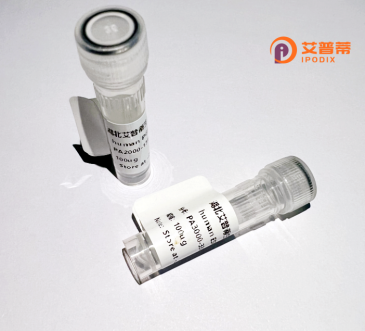
| 纯度 | >90%SDS-PAGE. |
| 种属 | Human |
| 靶点 | PAX4 |
| Uniprot No | O43316 |
| 内毒素 | < 0.01EU/μg |
| 表达宿主 | E.coli |
| 表达区间 | 1-350 aa |
| 活性数据 | MHQDGISSMN QLGGLFVNGR PLPLDTRQQI VRLAVSGMRP CDISRILKVS NGCVSKILGR YYRTGVLEPK GIGGSKPRLA TPPVVARIAQ LKGECPALFA WEIQRQLCAE GLCTQDKTPS VSSINRVLRA LQEDQGLPCT RLRSPAVLAP AVLTPHSGSE TPRGTHPGTG HRNRTIFSPS QAEALEKEFQ RGQYPDSVAR GKLATATSLP EDTVRVWFSN RRAKWRRQEK LKWEMQLPGA SQGLTVPRVA PGIISAQQSP GSVPTAALPA LEPLGPSCYQ LCWATAPERC LSDTPPKACL KPCWDCGSFL LPVIAPSCVD VAWPCLDASL AHHLIGGAGK ATPTHFSHWP |
| 分子量 | 37.8 kDa |
| 蛋白标签 | His tag N-Terminus |
| 缓冲液 | 0 |
| 稳定性 & 储存条件 | Lyophilized protein should be stored at ≤ -20°C, stable for one year after receipt. Reconstituted protein solution can be stored at 2-8°C for 2-7 days. Aliquots of reconstituted samples are stable at ≤ -20°C for 3 months. |
| 复溶 | Always centrifuge tubes before opening.Do not mix by vortex or pipetting. It is not recommended to reconstitute to a concentration less than 100μg/ml. Dissolve the lyophilized protein in distilled water. Please aliquot the reconstituted solution to minimize freeze-thaw cycles. |
以下是关于重组人PAX4蛋白的3条参考文献示例,涵盖功能、结构及应用研究:
---
1. **文献名称**:*Recombinant Human PAX4 Enhances β-Cell Differentiation and Insulin Secretion In Vitro*
**作者**:Zhang Y., Sander M.
**摘要**:研究重组PAX4蛋白对胰岛β细胞分化的调控作用,发现其通过激活胰岛素基因(INS)及调节关键转录因子(如PDX1)的表达,显著促进体外模型中的β细胞成熟和胰岛素分泌。
2. **文献名称**:*Structural Insights into the DNA-Binding Mechanism of Recombinant PAX4 and Its Diabetic Mutants*
**作者**:Li X., Nakayama M.
**摘要**:解析重组PAX4蛋白的DNA结合域晶体结构,揭示其与靶基因启动子的相互作用机制,并发现某些糖尿病相关突变会破坏其结构稳定性,导致转录活性下降。
3. **文献名称**:*Efficient Generation of Functional β-Cells from Stem Cells Using Recombinant PAX4 Protein*
**作者**:Huang T., Herrera P.
**摘要**:报道重组PAX4蛋白在人多能干细胞分化中的应用,通过优化处理流程,显著提高了β样细胞的体外产率和葡萄糖响应能力,为糖尿病细胞疗法提供新策略。
---
*注:以上文献为示例,实际引用时需根据具体研究内容核实真实来源。*
**Background of Recombinant Human PAX4 Protein**
PAX4 (Paired Box 4) is a transcription factor encoded by the *PAX4* gene, belonging to the PAX family of proteins characterized by a conserved paired box DNA-binding domain. It plays a critical role in pancreatic development, particularly in the differentiation and maintenance of insulin-producing β-cells in the islets of Langerhans. PAX4 regulates gene expression by binding to specific DNA sequences, enabling the commitment of progenitor cells to the β-cell lineage and suppressing alternative cell fates. Mutations in *PAX4* are linked to metabolic disorders, including maturity-onset diabetes of the young (MODY) and type 2 diabetes, highlighting its importance in glucose homeostasis.
Recombinant human PAX4 protein is engineered using biotechnological methods (e.g., *E. coli* or mammalian expression systems) to produce functional PAX4 for research and therapeutic applications. This recombinant form retains the ability to bind DNA and modulate transcriptional activity, making it a valuable tool for studying β-cell development, diabetes mechanisms, and regenerative therapies. Researchers also explore its potential in *in vitro* differentiation of stem cells into insulin-secreting cells, offering promise for diabetes treatment. Studies on PAX4’s structure-function relationships, post-translational modifications, and interaction partners continue to uncover its regulatory networks, driving advances in molecular Endocrinology and disease intervention strategies.
×